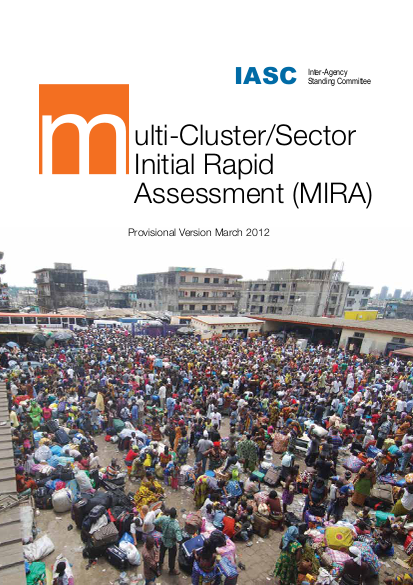
• The Multi-Cluster/Sector Initial Rapid Assessment (MIRA) is designed to identify strategic humanitarian priorities during the first weeks following an emergency. • The main benefit of the MIRA is the elaboration, from the onset of the crisis, of a concerted operational picture based on the best information available from primary and secondary sources. • This picture is expressed through two key products: a Preliminary Scenario Definition, is- sued 72 hours after the disaster’s onset, and a MIRA Report, released after 2 weeks. • It is consistent with the IASC Operational Guidance for Coordinated Assessments in Humanitarian Crises, which calls for the implementation of a joint assessment during the first two phases of an emergency and, thereafter, for the coordination of in-depth agency and cluster assessments. • The MIRA is the first step in the humanitarian country team’s response to an emergency. Based on its findings, humanitarian actors can develop a joint strategic plan, mobilize re- sources and monitor the situation and the response. However, the MIRA should not be ex- pected to provide detailed information for the design of localized response projects. • The MIRA should be carried out by a team of emergency specialists, including assessment and sectoral specialists, drawn from the various clusters/sectors present in the country to ensure that local knowledge is included in the findings. Additional headquarters and region- al support may be required, depending on the scale of the emergency. • It proposes a Framework to guide the identification of information needs and the system- atic collection, collation and analysis of secondary and primary data.This Framework forms the basis of the Preliminary Scenario Definition and the MIRA Report templates. • The Preliminary Scenario Definition and the MIRA Report provide assessment findings at critical intervals of the emergency.The Preliminary Scenario Definition should be included in the initial Flash Appeal whereas key findings of the MIRA Report should be captured in the Humanitarian Dashboard and included in the revised appeal to highlight the evidence on which the appeals are based. • OCHA coordinates the assessment, supports the compilation of secondary data from the various clusters/sectors and provides information management on behalf of the Resident/ Humanitarian Coordinator.If OCHA is absent or unable to serve this function,the Resident/ Humanitarian Coordinator may appoint another agency. • This manual is 20-pages long and comes with an additional five annexes providing support- ing information.